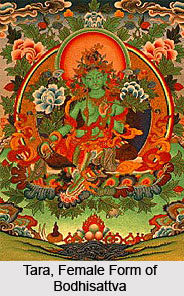 Tara in Buddhism is the female form of Bodhisattva. She is looked upon as a savior and compassionate goddess. But the worship of Tara is predominant in Tibetan Buddhism. Here she is also known as Sgrol-ma. It is believed in Tibetan Buddhism that the compassion of goddess for the earthly souls is stronger that the love of a mother for her child. She also symbolizes long life; guards earthly travel and shields her children when they are on their spiritual journey to enlightenment.
Tara in Buddhism is the female form of Bodhisattva. She is looked upon as a savior and compassionate goddess. But the worship of Tara is predominant in Tibetan Buddhism. Here she is also known as Sgrol-ma. It is believed in Tibetan Buddhism that the compassion of goddess for the earthly souls is stronger that the love of a mother for her child. She also symbolizes long life; guards earthly travel and shields her children when they are on their spiritual journey to enlightenment.
The origin of goddess Tara is rooted in Hinduism. It was adopted by Buddhism around 6th century. Before this time the feminine equivalent of Bodhisattvas was not recognized by Buddhists. According to legends goddess Tara was out of the tears of Avalokiteshvara bodhisattva. He was miserable when he witnessed the pain and torment around him. He wept and a lake was formed with his tears. A lotus blossomed in this lake and goddess Tara emerged from it. Another legend says that two forms of Tara emerged from Avalokiteshvara`s tears. One was born from his left eye (White Tara) and the other surfaced from his right eye (Green Tara). She is also seen as the companion of Avalokiteshvara.
There are different forms in which the Tara is worshipped in Buddhism. She is represented in different colors. But the most popular ones are the White and Green Taras. In the Buddhist iconography White Tara is seen as a maternal figure. She is considered the mother of all Buddhas. The pristine white hue of the deity stands for Truth, Purity and Wisdom. She has 7 eyes, which symbolizes her alertness to the well being of her children. She is able to see the trauma and agony through which her children pass.
She is seated draped in white robe and bejeweled. She sits on a lotus and her posture oozes with calmness and grace. The lotus in her hand represents Buddha Kashyapa, Buddha Sakyamuni and Maitreya. The goddess helps her followers to overcome all the odds to practice Buddhism and attain longevity.
Green Tara represents action and vitality. Though her form is fierce yet she is the savior goddess. Some Buddhists consider her the original Tara as she is seen as the wife of Avalokiteshvara. Her posture reflects the readiness to act. There is an ease about her too. She holds a closed lotus that stands for power and purity. She is dressed with rich ornaments of a bodhisattva. She helps her followers overcome the fears, worries and the most complex situations that arise in the way of religious accomplishments. She is compassionate as she is quick to respond to the alarming calls of her devotees.
The other form of Taras are Red Tara, Black Tara, Yellow Tara, Blue Tara, Cittamani Tara and Khadiravani Tara. This form of Bodhisattva is also considered to be the tantric deity. She is also seen as playful as in certain places she is depicted as a 16 year old. To put it briefly Tara encompasses all the feminine qualities. The representation of Tara is primarily found in Mahayana Buddhism and Tibetan Vajrayana.









